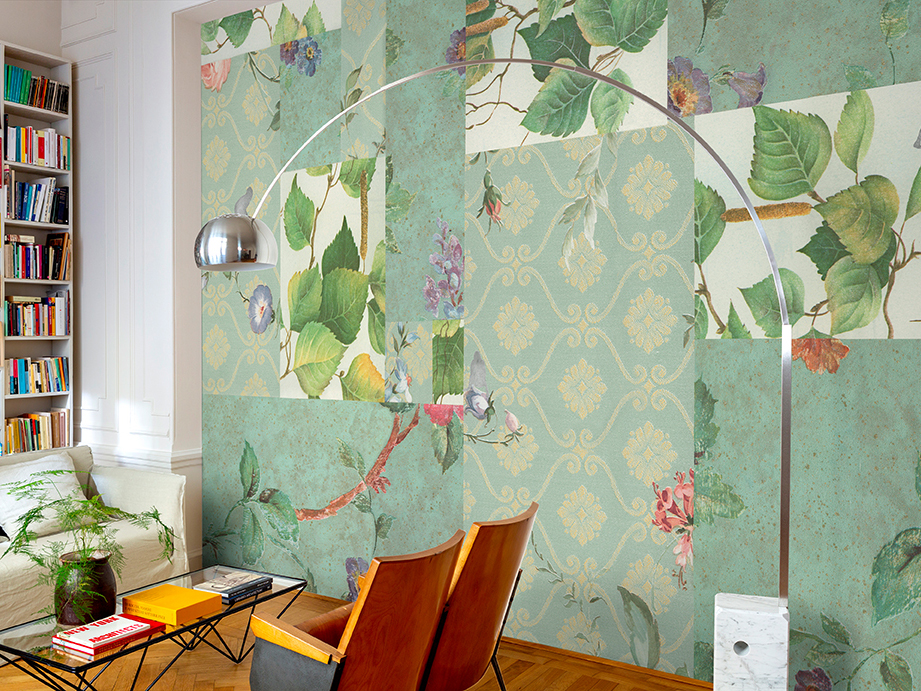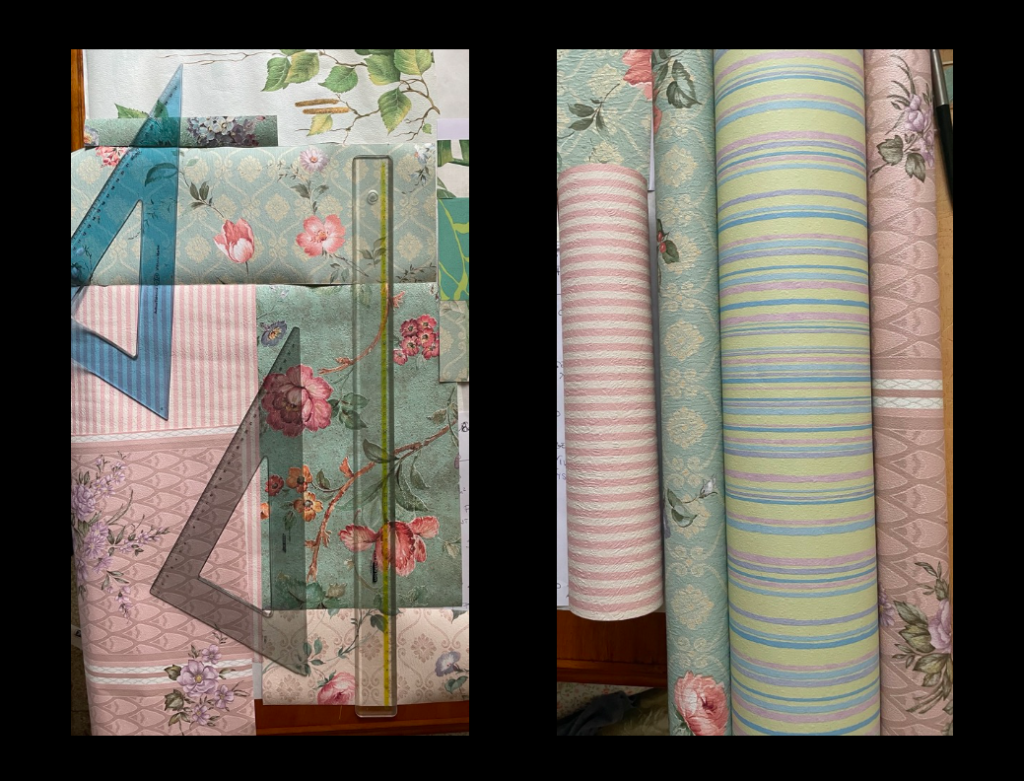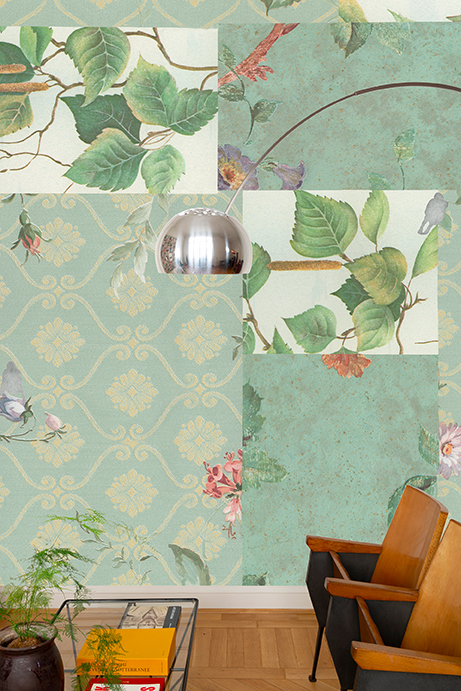Wall&decò
with CARTEdition
by AtemporaryStudio
Ho cercato la composizione e l’armonia; i diversi elementi si alternano per restituire un’unica superficie, leggera e il più possibile ariosa. – Donatella Spaziani
- ph. Silvia Revoltella
La fonte di ispirazione dell’intera collezione è lei, Donatella Spaziani. E’ stata una delle prime artiste con le quali ho lavorato quando trasferita a Roma, dal 2003, grazie a RAMradioartemobile.
Donatella Spaziani in quegli anni iniziava a utilizzare la carta da parati come porzione di spazio su cui intervenire direttamente con la tecnica del disegno.
Nata l’idea di realizzare dei progetti d’artista su wallcovering fu lei la prima artista ad essere interpellata. Un percorso lineare che parte dall’utilizzo della tappezzeria come genesi dell’opera alla realizzazione di una vera e propria carta da parati.
L’aspetto di Wall&decò with CARTEdition che mi interessa maggiormente è la possibilità di poter comporre io la superficie sulla quale far muovere i miei elementi.
Così nasce 1:5, attraverso un processo circolare partendo dall’utilizzo di antiche carte da parati assemblate insieme in un patchwork colorato per arrivare all’opera finita. Scansionate e ingigantite per 5 volte, le antiche carte si trasformano alterando l’immagine originale in un’esplosione di figure giganti e innumerevoli dettagli. Sagome di figure nere compaiono anche in questo progetto, trasposte a parete attraverso la tecnica del disegno, fluttuanti tra macroscopici fiori e particolari solitamente invisibili.
La tecnica dell’assemblaggio di ritagli di carte diverse rende libero l’incontro simbolico di tre storie. Le carte utilizzate sono tutte di inizio Novecento e provengono dalle Case comunali di San Pietroburgo, dall’Inghilterra e da Parigi. Altrettanto libero è l’accostamento dei ritagli, nessuna preoccupazione nella gestione delle proporzioni o dei punti di congiunzione a favore del confronto marcato delle differenze.
Guardando 1:5 si attiva un gioco di percezione che apre a diversi punti di vista e prospettive dello stesso progetto in base alla distanza con cui lo guardiamo. Come se l’artista avesse applicato una lente di ingrandimento sulla parete, si mette in rilievo il dettaglio a favore del tutto in un tributo alla storia e alla flessibilità di un nuovo supporto – il wallpaper – entrato nella ricerca artistica contemporanea.
L’arte può restituire un’idea di bellezza e valore più autentica che spinga a scartare il superficiale. La carta da parati ha in sé ampiamente questa possibilità.
Un’esperienza di incontro interessante con Wall&decò nonché di confronto stimolante con Christian Benini, art director e fondatore dell’azienda.
Solitamente lavoro in un percorso piuttosto solitario, l’incontro con Cristian e lo staff di wall&decò mi ha permesso di condividere, discutere il progetto, misurarmi con le dinamiche di una grande azienda (nel senso anche di grande professionalità e competenza) e dunque di un punto di vista differente. Capire le necessità del sistema di produzione, confrontarci fino ad arrivare a trovare il punto d’incontro, è stata una grande opportunità che ha aperto a nuove possibilità.
I sought composition and harmony; the different elements alternate to create a single surface, light and as airy as possible. – Donatella Spaziani
Donatella Spaziani herself is the source of inspiration for the entire collection. She was one of the first artists I worked with after her move to Rome, from 2003, thanks to RAMradioartemobile.
During that period Donatella Spaziani began to use wallpaper as a piece of space on which she could draw directly.
When the idea of creating artist’s projects on wallcovering was born, she was the first artist to be consulted. A linear path that starts from the use of tapestry as the genesis of the work to the creation of an actual wallpaper.
The aspect of Wall&decò with CARTEdition that interests me most is the possibility of being able to create for myself the surface on which my elements will exist.
In this way the artista gives life to the project entitled 1:5, through a circular process starting from the use of old wallpapers assembled together in a coloured patchwork to become her wallcovering design. Scanned and enlarged five times, the old papers are transformed, altering the original image in an explosion of giant figures and countless details. Black silhouettes of figures also appear in this project, transposed on the wall through the technique of drawing, floating between macroscopic flowers and usually details that are usually invisible.
The technique of assembling scraps of different papers sets free the symbolic encounter of three stories. The papers used are all from the beginning of the twentieth century and come from St Petersburg, England and Paris. Equally free is the juxtaposition of the cut-outs, with no concern for proportions or points of conjunction, to favour a marked comparison of their differences.
Looking at 1:5 activates a game of perception that opens up different points of view and perspectives of the same project depending on the distance from which we look at it. As if the artist had applied a magnifying glass to the wall, the detail is emphasised in favour of the whole in a tribute to the history and flexibility of a new medium – wallpaper – which has become part of contemporary artistic research.
Art can restore a more authentic idea of beauty and value that pushes us to discard the superficial. Wallpaper has this possibility within itself.
An interesting meeting with Wall&decò as well as a stimulating discussion with Christian Benini, art director and founder of the company.
Usually I work in a rather solitary way, meeting Cristian and the staff of Wall&decò allowed me to share, to discuss with them about the project, to measure myself with the dynamics of a big Company (in the sense also of great professionalism and competence) and therefore with a different point of view. Understanding the needs of the production system, confronting each other until we found a common ground, was a great opportunity that opened up new possibilities.








